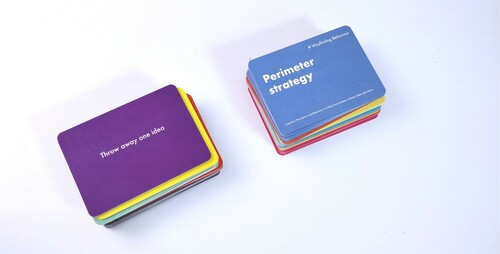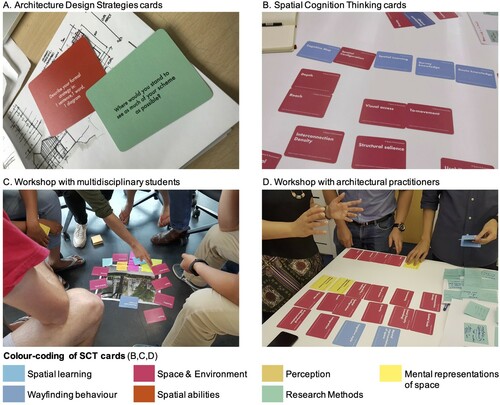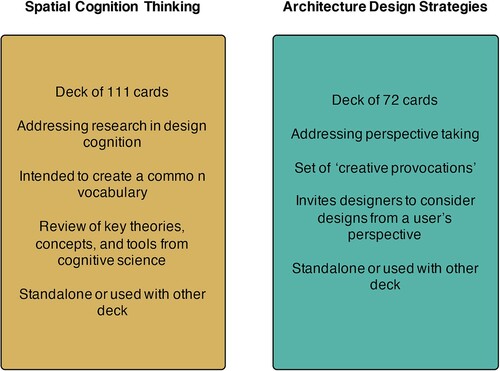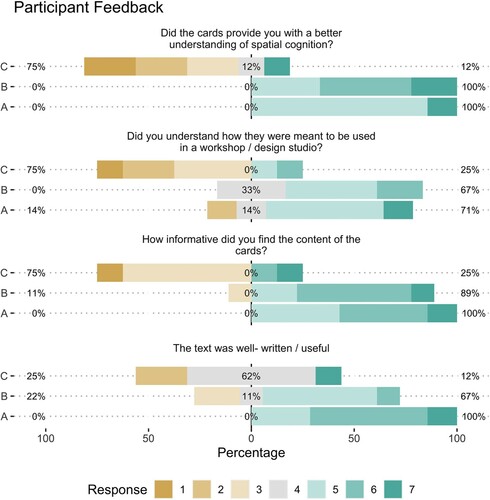Figures & data
Figure 1. Diagram of the relationship between perspective-taking, design cognition and architectural cognition. Design practitioners design buildings (and other settings) while striving to anticipate and respond to the needs of end-users. The disciplines of architectural cognition, together with design cognition, can support this process by providing a knowledge-scaffold around the typical practice of perspective-taking. Diagram adapted from Conroy Dalton et al. (Citation2013).

Figure 2. The two decks of cards: the Architecture Design Strategies Cards (left) aim to provoke perspective-taking and empathy, while the Spatial Cognition Thinking Cards (right) aim to promote a shared understanding of cognitive science concepts and evidence-based design, offering a shared vocabulary between researchers and designers.

Figure 3. Images of using the two card decks in the design studio and in workshops. (A) the Architecture Design Strategies cards being used in the postgraduate architectural studio. (B) Spatial Cognition Thinking cards laid-out on the table at the end of the workshop with practitioners, organized in terms of (perceived) project relevance. (C) Group of multidisciplinary students, using the Spatial Cognition Thinking cards to discuss which aspects of spatial cognition can help understand people's behaviour in a major pedestrian street. (D) Spatial Cognition Thinking cards organized in column by practitioners and used to structure a discussion on user behaviour in complex buildings. Image credits: Dalton, Hölscher, and Montello Citation2019 (A); Saskia Kuliga 2019 (B,C,D).

Figure 4. Distinguishing characteristics of the two card decks, including the number of cards per deck, objective, and mode of use.

Table 1. The structure of the two card-decks.
Table 2. Testing of the Architecture Design Strategies (ADS) and Spatial Cognition Thinking (SCT) cards.
Figure 5. Example workshop materials for to use the two cards decks during user-centred perspective-taking exercises. Right: A picture from the Orchard MRT (metro) station in Singapore (Credit: Panagiotis Mavros Citation2019), was used for egocentric perspective-taking. Left: A plan-view of a major shopping mall in Singapore, used as an example of complex public building which should accommodate the needs of diverse user groups, serves as a prompt for allocentric perspective-taking (Credit: Panagiotis Mavros Citation2019).

Figure 6. Word cloud visualising the word frequency analysis from the focus group discussions, where the Architecture Design Strategies Cards were used (n.b. common words omitted). The most frequent words, e.g. think, question, and differently, support our objective to encourage the critical reflexion (questioning and re-thinking) of the students' own designs.

Table 3. Examples of comments assigned to different thematic codes.
Figure 7. Likert-plot showing participant feedback to each workshop (note this does not include the design-studio). Reading from left to right, percentages show the percent of responses that were negative (i.e. aggregating responses 3 or lower), neutral (4), or positive (i.e. aggregating responses 5 and above). A difference in the responses can be observed for all questions between the two facilitated workshops (A, B) and the non-facilitated one (C).

Table 4. Descriptive statistics of responses to the workshop evaluations.
